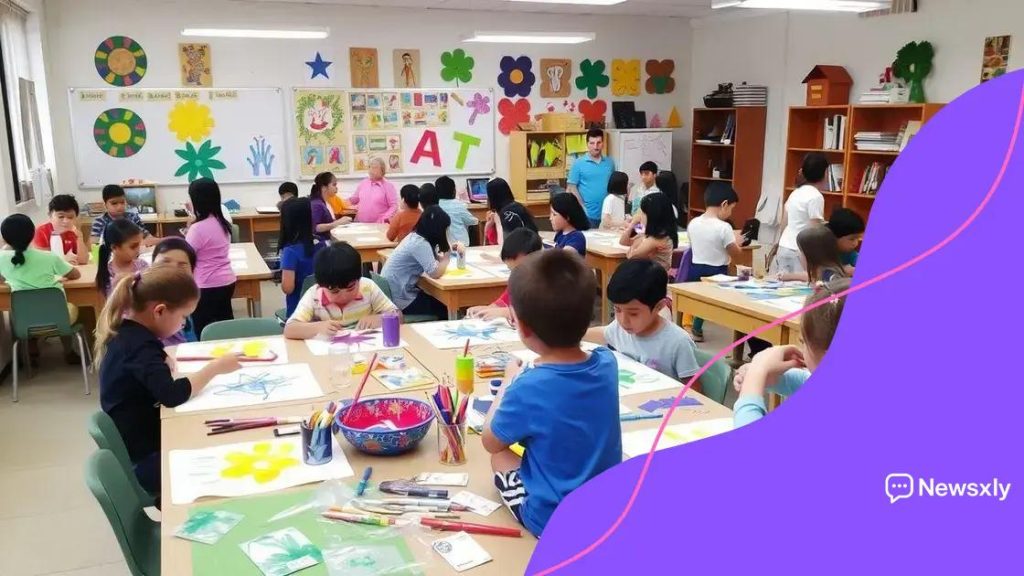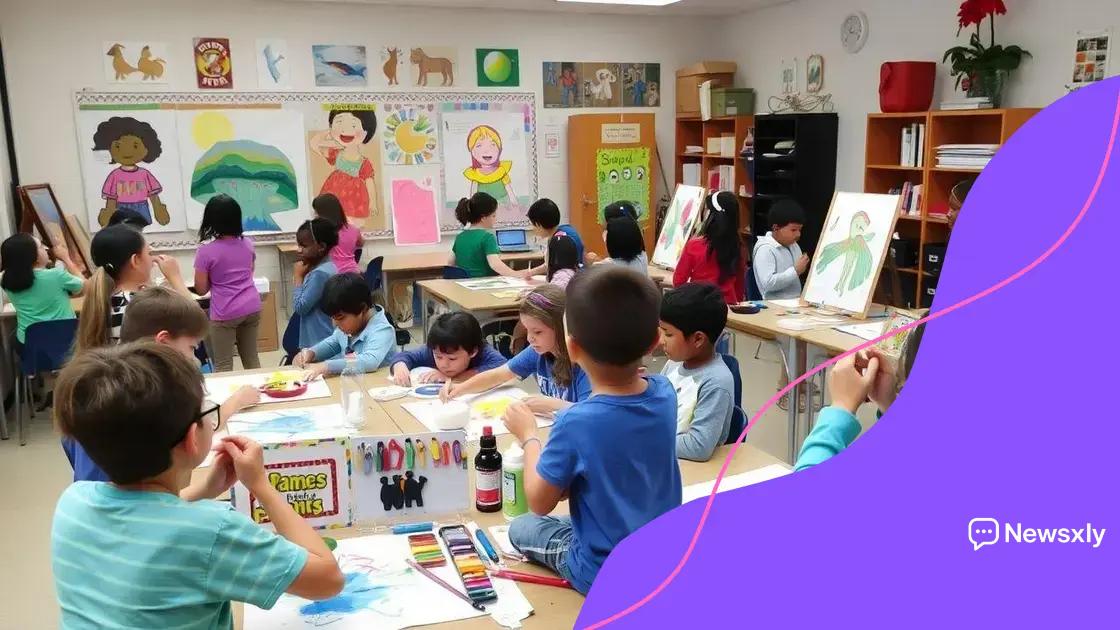The importance of arts education in shaping futures

Advocating for arts in school curriculums enhances creativity, improves academic performance, and fosters emotional expression, resulting in well-rounded student development and a vibrant school community.
The importance of arts education is often overlooked, yet it plays a crucial role in developing well-rounded individuals. Have you ever considered how creativity influences problem-solving and innovation? This article dives into the essential benefits of integrating arts into education.
Understanding the benefits of arts education
Understanding the benefits of arts education is vital for recognizing its importance in schools. It isn’t just about creating art; it enhances a child’s overall development. Research shows that students who engage in the arts are more likely to excel academically.
Enhancing Creativity
One of the primary benefits of arts education is the enhancement of creativity. When students participate in artistic activities, they learn to think outside the box and express their unique ideas. This creativity can lead to innovation in other subjects as well.
Improving Academic Performance
Arts education correlates with better performance in core academic subjects. Numerous studies reveal that students involved in arts programs tend to achieve higher scores in math and reading. This demonstrates that the skills developed through arts education are transferable to other areas.
- Increased critical thinking skills
- Improved focus and concentration
- Enhanced collaboration and teamwork
- Greater engagement in school
Another notable benefit is its ability to foster emotional development. Engaging in the arts helps students express their feelings and communicate better with others. This can lead to improved relationships and a more positive school environment.
Building Confidence
Participating in the arts also boosts students’ confidence. Whether performing in front of an audience or displaying their artwork, the experience of sharing their talent encourages a sense of achievement. This newfound confidence often carries over to other academic pursuits.
Ultimately, understanding the benefits of arts education highlights its critical role in nurturing well-rounded individuals. By integrating arts into education, we prepare students not just for academic success but for life itself. They leave school as creative problem solvers, effective communicators, and confident individuals ready to face future challenges.
Core subjects vs. arts: finding balance
Finding balance between core subjects and arts education is crucial for a well-rounded curriculum. While subjects like math, science, and reading are fundamental, the inclusion of the arts enriches students’ educational experiences. This balance fosters creativity while ensuring academic rigor.
The Importance of Core Subjects
Core subjects provide essential skills that are necessary for understanding the world. They teach critical thinking, problem-solving, and analytical skills. Mastery in these areas lays the foundation for future success in education and careers.
The Role of Arts Education
On the other hand, arts education is equally important. Involvement in the arts promotes emotional intelligence and self-expression. Students learn to communicate thoughts and feelings through various mediums like music, dance, and visual arts. This self-expression enhances their overall well-being.
- Arts education improves creativity.
- Engaging in the arts supports emotional and social development.
- Students gain valuable skills applicable to other fields.
- Balance in the curriculum encourages holistic learning.
When schools prioritize both core subjects and arts, they create an environment where all aspects of a child’s development thrive. Students who are engaged in both areas tend to show increased motivation and enthusiasm for learning.
Strategies for Finding Balance
To achieve a balance, schools can implement integrated learning approaches. For example, incorporating art projects in science lessons can make learning more engaging. Additionally, offering flexible schedules allows students to participate in both core and arts courses without sacrificing either.
Communication among educators, parents, and students is key in finding this balance. Understanding the unique benefits of both educational paths helps in creating a supportive learning environment. When schools embrace both core subjects and arts education, they produce well-rounded individuals prepared to navigate diverse challenges in life.
How arts education encourages creativity

Arts education plays a crucial role in encouraging creativity among students. Engaging in various art forms allows students to explore their artistic expression while developing unique ideas. This exploration not only fosters imagination but also boosts confidence in their creative abilities.
Benefits of Expressive Arts
Participating in expressive arts instills a sense of freedom in students. By creating music, painting, or acting, they learn to express emotions in ways that words often cannot. This process encourages individuals to think differently and approach problems with an open mind.
Developing Innovative Thinkers
Arts education enhances students’ ability to innovate. It teaches them to take risks and embrace failure as part of the learning process. When students engage in artistic activities, they learn that it’s okay to be imperfect. This lesson is vital for nurturing a growth mindset.
- Arts education promotes experimentation and exploration.
- Students learn to connect disparate ideas creatively.
- Collaboration in art projects fosters teamwork and shared creativity.
- Involvement in the arts boosts self-esteem and personal expression.
Moreover, the skills gained through arts education can easily transition to other academic areas. For instance, a student who learns to think creatively in an art class can apply that same creativity to solve math problems or approach science experiments differently. This interconnectedness supports a more engaging learning experience.
Creating a Supportive Environment
A supportive environment is essential for encouraging creativity. Educators should cultivate spaces where students feel safe to express their ideas without judgment. This can include providing opportunities for collaboration and praise for creative efforts, no matter the outcome. In this sociable setting, students can thrive as inventive thinkers.
Ultimately, arts education is not just about art itself; it’s about empowering students to think creatively and critically. By encouraging creativity, we prepare students for a future filled with challenges that require innovative solutions. The creativity sparked by the arts can lead to remarkable achievements in all walks of life.
Real-world skills gained from arts education
Arts education provides students with valuable real-world skills that extend beyond the classroom. These skills are vital for personal development and future career opportunities. Engaging in artistic activities teaches students how to effectively communicate and collaborate with others.
Communication Skills
One major benefit of arts education is its focus on enhancing communication skills. Through visual arts, music, and theater, students learn to express their ideas clearly and confidently. This ability to articulate thoughts is crucial, not only in academics but also in professional settings.
Problem-Solving Abilities
Participating in the arts encourages students to think critically and develop problem-solving abilities. When faced with challenges during a project, students must figure out creative solutions. This practice trains them to approach problems from multiple angles, which is a key skill in any career.
- Collaboration with peers fosters teamwork skills.
- Using feedback to improve works enhances adaptability.
- Learning to manage time effectively for projects builds organizational skills.
- Engagement in presentation prepares students for public speaking.
Moreover, arts education provides opportunities for leadership. Students often take charge of projects, guiding their classmates and making decisions. This leadership experience is beneficial in any workplace where teamwork is essential.
Enhancing Cultural Awareness
In addition, engaging in arts exposes students to diverse cultures and perspectives. This cultural awareness helps them become more empathetic and understanding individuals. Being aware of different viewpoints is important in today’s global society, providing a richer understanding of their community and the world.
By integrating the arts into education, students gain a well-rounded skill set that prepares them for the realities of adulthood. The real-world skills acquired through arts education—communication, problem-solving, collaboration, leadership, and cultural awareness—are essential not just in their personal lives but also in their future careers.
Advocating for arts in school curriculums
Advocating for arts in school curriculums is essential for fostering a balanced education. Despite the focus on core subjects like math and science, arts education should not be overlooked. It enriches the learning experience and contributes significantly to a student’s development.
The Importance of Advocacy
Advocacy for arts programs helps raise awareness among educators, parents, and policymakers about the benefits these programs provide. Promoting the arts in schools can lead to wider recognition of their value. This recognition is crucial for securing funding and resources necessary for these programs.
Benefits of Arts Advocacy
When arts education is included in school curriculums, students gain numerous advantages, including:
- Enhanced creativity and critical thinking skills.
- Improved academic performance across various subjects.
- Greater emotional expression and understanding.
- Increased engagement and motivation to learn.
These benefits are not only beneficial to students but also positively impact the school community as a whole. A strong arts program can promote school spirit and engagement, creating a more vibrant educational environment.
Strategies for Effective Advocacy
The effectiveness of advocating for arts education can be enhanced by employing specific strategies. One key approach is to share success stories that highlight how arts programs have transformed students’ lives. These real-life examples can resonate with decision-makers.
Additionally, forming partnerships with local arts organizations can help support school programs. Collaborating with community artists and performers brings real-world experiences into the classroom. This not only enriches students’ learning but also draws attention to the importance of arts in education.
Ultimately, advocating for arts in school curriculums requires a collective effort from everyone involved. By emphasizing the numerous benefits of arts education, we can ensure that future generations receive a well-rounded education that includes vital artistic experiences.
FAQ – Frequently Asked Questions about Arts Education in Schools
Why is arts education important in schools?
Arts education is crucial because it enhances creativity, improves academic performance, and encourages emotional expression among students.
How can arts education impact a student’s future career?
By fostering skills like communication, collaboration, and problem-solving, arts education prepares students for diverse career paths.
What benefits do schools gain from integrating arts into their curriculum?
Schools with strong arts programs see increased student engagement, improved school culture, and enhanced community involvement.
How can parents and educators advocate for arts education?
Parents and educators can advocate by sharing success stories, forming partnerships with local arts organizations, and communicating the benefits to policymakers.





